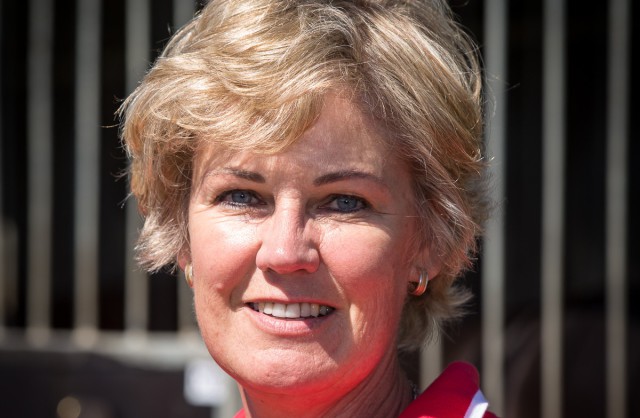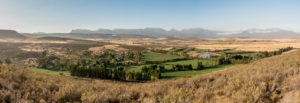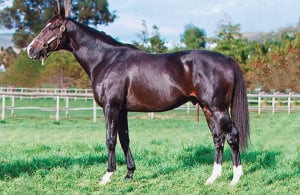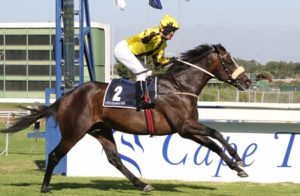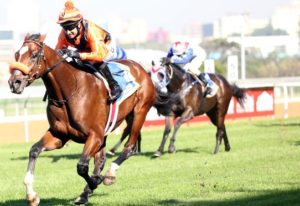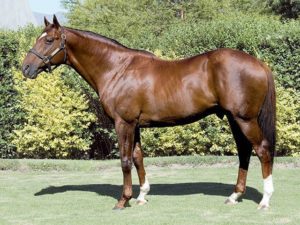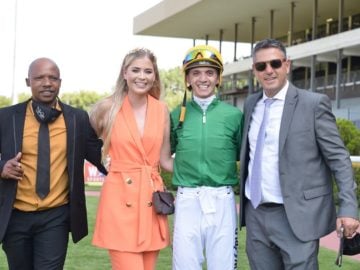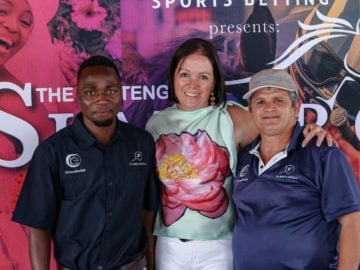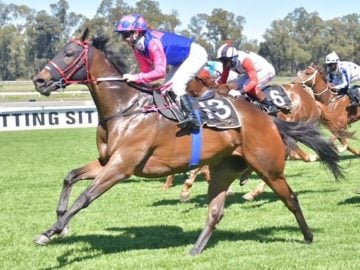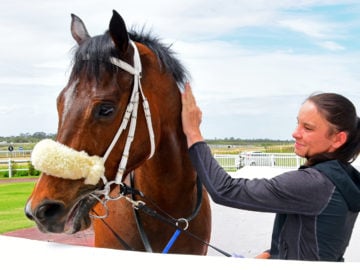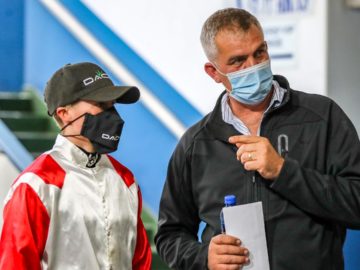Sally Jourdan has been with Lammerskraal since 1987 and overseen the expansion of the farm, the development of the broodmare band, the phenomenon that was Western Winter and the farm’s recent sale to Pieter Graaff. With Abashiri grabbing headlines in last weekend’s Betting World Gauteng Guineas and Go Deputy very much alive and well in the Lammerskraal stallion paddock, the future looks rosy.
About Sally
Sally Jourdan grew up in Durban to an entirely unhorsey family. However, the bug bit when her fondness for German Shepherds found her at obedience classes at the Greyville racecourse infield and the sight of the galloping racehorses first captured her imagination.
Her father was a regular buyer of the Mercury and Daily News and Sally remembers him allowing her to play a 50c PA as early as age 10. “I’d give him a straight line and we would often win,” she smiles. Her godparents had a farm in Balgowan where Sally learnt to ride and her fate was sealed. Her family moved to Komga in the Eastern Cape when she was 16 and Sally got her first horse. “It cost me R2/month to keep him on the common. I’d have to walk out of the village to catch him, walk him back, brush him, saddle up and go riding. My dad probably got me into horses, but my mom was probably the one who supported me most. I’d sit and read the racing pages out loud and chat away for hours, mostly about their breeding, and my mom would have to sit and listen,” she remembers fondly. By the time Sally left home, she had collected 7 horses for her mom to take care of!
After a year of secretarial college and 2 years working in a bank, Sally decided that the corporate world was not for her. She gained experience with Terry Silcock’s Starston Stud and when visa complications put paid to a job offer at Juddmonte Farms in the UK, she adjusted her compass and made for the Western Cape instead, eventually landing a job at Daytona’s quarantine station. A keen sportswoman, Sally played squash every evening and weekends were dedicated to playing polocrosse, where she met Mike Rattray’s son, Chris. “John Kramer had found the farm for Rattray back in 1983 and it was originally a wheat farm. I used to come to the farm for parties and braais. The farm was very undeveloped and there wasn’t a tree on the place, but I could see it had potential and made up my mind that I wanted to work there.” Despite Chris’s protests that it would be too much of a challenge, Sally joined the Lammerskraal team in August 1987. When Chris left to play polo and farm in KZN two years later, Sally applied for the manager’s job, but was told they were looking for a man. Sally sat down and wrote a long letter setting out why she was the person for the job. When Chris approached his father, Mike asked “Do you trust her? If you do, we should give her a chance.”
Girl power
“It was tough,” says Sally, “But it taught me to stand on my own two feet. I had to take the mares to be covered, drive the trucks to fetch feed and roughage and there was no secretary, so I did the office work and wages by hand. I put in irrigation, planted trees and learnt about pastures and crop farming as I went along. I asked other breeders what pasture mix they used and I liked to read, so I did a lot of research and we put a lot of time and effort into our pasture management.
Under Sally’s watchful eye, the stud grew and expanded and is currently made up of a collection of four farms. Sally implemented a strict pasture management regime which ensures perennial high quality grazing. The farm grows its own high quality teff, oathay and lucerne as well as producing its own bedding from barley. They still have the herds of sheep which gave Lammerskraal its name, as well as Angus stud cattle and new owner, Pieter Graaff’s herd of Brown Swiss.
Going commercial
“At the time I joined they stood an Argentinian stallion called Enduzante and about 11 Argentinian mares, mostly bought by Ralph Rixon. I told Rattray that we had no chance of being commercial with the existing stock and we made the decision to do it properly. We went to the Pietermaritzburg mare sale and bought Saintly Lady and Welsh Woman. For many years thereafter Rattray purchased every good race filly he could. After all, the best race fillies will be your better broodmares.”
Stallion roster
A few years later they decided a stallion was needed and nearly a year’s worth of research went into the purchase of Western Winter. “Charles Faull found him for us. We’d considered him a year earlier, but decided he hadn’t done quite enough yet. Of course, by the time we did want him, the price had gone up. I flew out to Belmont to look at him and he just had this amazing presence. Rattray phoned and asked whether I wanted him and I said yes.”
“He had a white eye, which some people were nervous of, but there was no temperament with it. We used to keep the stallions at the stallion barn at one end of the farm, but Western Winter had such a good temperament that we realised he did better with company and eventually we kept him in the broodmare barn with his mares.” Western Winter helped build up the farm – both in terms of reputation as well as in brick and mortar terms and when he died in 2013, they buried him next to the stallion barn with a fittingly large memorial slab overlooking his kingdom.
Western Winter was joined by Rakeen, Parade Leader and most recently, Go Deputy, sire of the impressive 2016 Betting World Gauteng Guineas winner, Abashiri.
The importance of family
The new regime paid dividends and the winners started coming with horses such as Celtic Grove, Set Afire, Drift Ice, Yard-Arm, Jagged Ice, Rudra, Solo Traveller, Viva Maria, Red Ray, Brutal Force, Nania and Capetown Noir amongst others. However, asked to name stand out horses, Sally says that it’s the disappointments that stick with you more than the successes. “Often you’ll have a foal and think this is a really nice horse, but then it disappoints when it gets to the track. And it’s not always the horse’s fault. That’s why it’s so important to know each family and each horse,” she stresses earnestly.
“Yard-Arm was always a nice horse – he was sleek and elegant and always had this incredible athleticism about him.” Of course there are always the surprises. “Celtic Grove was a big block of a baby. When we broke him in at 2, he was almost like a Warmblood. I never anticipated he’d be as good as he was because he was so heavy.”
Sally says she does not use any of the pedigree programmes such as Tesio or Gr1 Goldmine, “I use the Charles Faull system” she quips. She also sets a lot of store in mares and in families and stresses the importance of knowing the family and history of each horse and this is perfectly demonstrated in the pedigree of Abashiri.
Abashiri
“The mare (Donya) was a half-sister to Yard-Arm by Elliodor. She had a very good Western Winter colt that ended up in Dubai, called Drift Ice. When I was looking for a name, I looked up drift ice and Abashiri is the name of the Japanese town that tourists visit every year to look at the drift ice.”
Abashiri was one of those ‘nice’ horses. “He reminded me of Yard-Arm. From day one he was a beautifully balanced, athletic horse and a great walker. As a yearling Abashiri was pretty much as he is now – leggy and gangly, but with this wonderful athleticism and balance – if you watch him run, you’ll see how he flattens like a cheetah. At the sales, Mike Azzie kept coming and pulling the horse out. He said he’d always wanted to buy a horse from us, but could never afford one. When the horse went into the ring, Tom Callaghan was talking to Adriaan van Vuuren in one of the cubicles and Mike was frantic trying to get Van Vuuren’s attention. Eventually they managed to get one bid in and the horse was knocked down to them. It’s one of those ‘meant to be’ stories.”
“So often when you take horses like him to the sales, you think you’ve got a standout on how it looks and walks and then no-one is interested or they go for less than what you expect and you wonder why other people can’t see what you do, particularly as those ones usually end up doing well on the track. I really think if guys know what they’re looking for and do their homework, you can buy horses like Abashiri that are not overpriced. Azzie knew and he kept coming back because he’d seen what he wanted.”
Go Deputy
“Go Deputy was Charles Faull again. He also found him about a year before we bought him and kept going on about this horse. I flew over to look at him at Todd Pletcher’s yard in Florida. We were looking for a stallion to mate Western Winter’s daughters to and thought he matched pretty well.”
“He’s a proper horse. He’s by Deputy Minister who was a champion racehorse, champion sire and champion broodmare sire. He’s out of a daughter to Secretariat. He’s a half-brother to Gr1 winners. He himself is a Gr1 winner and three times he was beaten a head and a neck in Gr1 races. And the Gr2 he won was subsequently upgraded to a Gr1. He’s a proper racehorse with a proper pedigree and the looks to match.”
“In a way it was almost a pity that Western Winter was such a raging success,” she muses. “Rattray thought we would simply do it again and decided not to syndicate any of his subsequent stallions, which made it very difficult and Go Deputy unfortunately lacked support from day one. It’s very sad, because he’s the sort of horse that would be one of our better stallions if he got more mares. His statistics are phenomenal – he’s on 41% winners to runners, which ranks him above sires like Dynasty and Silvano and his stakes winners to runners is 17%!”
“I don’t know whether anyone will suddenly send mares to Go Deputy, but it’s such a shame that a horse of this calibre is being so wasted. His foals are scopey and correct and very easy to work with, although they are late maturing. Go Deputies need to be taught and show improvement with time and patience. There’s unfortunately a perception that he’s a staying horse and that’s not true. They’re certainly not sprinters, but my own filly won from 1000m – 1400m and a lot of them can do a shorter distance. Often when they’re asked to go extended distances they disappoint, but when they’re brought back in trip they win well. I’d describe them more as milers.”
When Rattray got serious about his Angus cattle, his interest in the horses seemed to wane a little, but with the farm changing hands to Pieter Graaff at the end of 2014, there is renewed energy, vigour and more importantly, investment at Lammerskraal Stud. With a resident sire like Go Deputy in the paddock and Abashiri on the Triple Crown trail, with the passion of Michael Azzie and supportive owners like the Van Vuurens, success as Sally says, sounds like one of those ‘meant to be’ stories.


